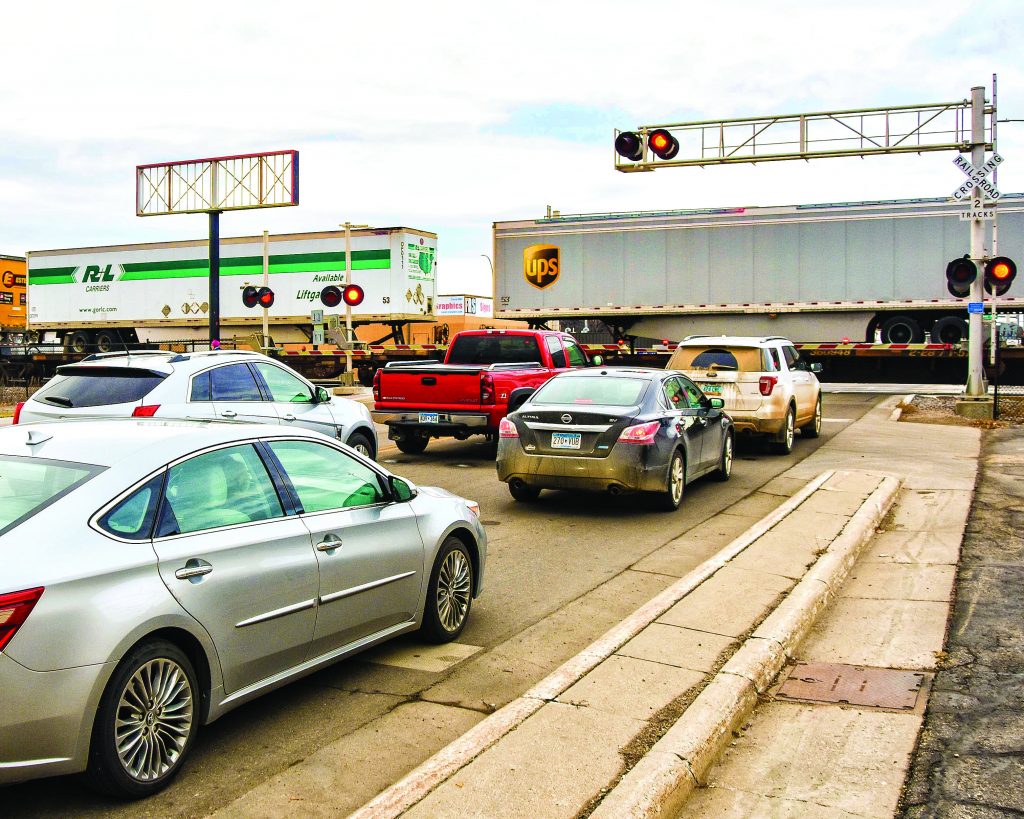
Nancy Edmonds Hanson
hansonnanc@gmail.com
Moorhead’s 147-year love-hate relationship with the railroad may come to a happy resolution in the next few years … with the city drawing ever closer to a way to dodge trains toward the center of town.
The double underpass proposed on 11th Street may be just the ticket. It would speed drivers beneath both of the rail lines that bisect the city. Starting at Second Avenue North, it would lower the street’s intersections with First, Center and Main avenues, with trains proceeding east and west on ground-level bridges along on the Prosper (north) and KO (south) lines. At the lowest point, auto and truck traffic would flow 20 feet below the present street level.
Discussed for decades, the dreamed-of a crossing at the midpoint of the developing downtown area would finally permit drivers to avoid long, backed-up lines waiting to cross the three key east-west routes. Its location north of the midtown Hornbacher’s – midway between the Third Street pass along the river and the new Main/20/21st reconstruction – would be a dream come true – and a potential life-saver.
“Emergency responders are held up at the crossings an average of nine times a month by freight trains,” city engineer Bob Zimmerman points out, quoting from a detailed study completed by the city and the Minnesota Department of Transportation. The underpass is projected to save $12 million in loss of property and life over 20 years.
Everyone traveling through Moorhead knows all about those delays. With 70 daily trains passing through the heart of the city, car and pedestrian traffic is held up a total of five hours – more than 20% of the hours in the day. Nor is as bad as it can get. With train traffic increasing a modest 1% per year and vehicular traffic growing by just half of 1%, some 90 trains are expected by 2045, with seven hours of blockage. Any growth beyond those projections, Zimmerman points out, will exceed the capacity of the system and, he says, “result in genuine traffic gridlock.”
City leaders agree that an underpass at 11th Street is the best solution. So does MnDOT; it has made the underpass its first priority safety priority between here and the Twin Cities. A long list of government and private entities has pledged support. “Honestly, I haven’t heard of any opposition at all,” Bob says.
But one rather significant obstacle remains: Finding the money.
It’s not an inconsiderable sum; though too early for firm estimates, Bob suggests the number will fall somewhere between $60 and $70 million. That’s comparable to the Main/20/21st project, which totals $72.9 million. The largest share was appropriated by the state, with smaller amounts from the city and BNSF Railway.
The situation is strikingly different for 11th Street, Bob points out, because this time two regional trunk highways, 10 and 75, run through the area. “That puts this project in a different perspective, compared to Main/20/21st, which was strictly a city matter,” he says. Small changes are already being made to both routes at the city’s center. Currently Highway 75 extends to Center Avenue before turning east, then swivels north on 11th Street. That’s being amended, turning eastward from Eighth Street at Main (the Dairy Queen corner). The revised route will then join with 11th Street at the Hornbacher’s intersection, then proceed underneath the proposed underpass.
This time, the city is partnering with MnDOT. “MnDOT has been an excellent partner,” he notes. The partners have applied for an alphabet’s worth of major federal grants, originally paired with the underpass near Moorhead High – TIGER, INFRA, BUILD – without success. They received word last week that the latest pitch for $25 million has also failed. “We’ve come very close the last two times, we think,” Bob says, “with USDOT telling us our applications were very good. But they’re highly competitive with every place in the country, and there wasn’t enough money to go around.”
Still, with the state’s help securing funds, he expects a happy outcome at last.
“Moorhead has been talking about something like this since the 1970s. They’ve been getting serious since the late 1990s,” he recounts. That’s when a major study supported by US Rep. Collin Peterson made recommendations that led to the 34th Street corridor on Interstate 94 and the Main/20/21st underpass. The interchange at 34th was completed in 2011; the underpass, now under construction, will open in 2020.
Bob doesn’t foresee the 11th Street construction process being as challenging as the current project. There, streets and rails converge from every angle into an asterisk-like footprint; 11th Street is far less complicated, though it too will require BNSF to construct two temporary “shoo-fly” detours while bridges are being built. Both do share one geological complication, however: “Our soil is terrible for construction.”
The city and MnDOT have already shared the cost of early preparation for the double underpass, pegged at $1.2 million, including environmental documentation and preliminary engineering. These steps will be completed in mid-2020. Final design and property acquisition lie ahead, dependent on securing funding from the Legislature in 2020. In the meantime, the staff will begin discussing options with property owners in the affected area by the first of the year.
Still, much work remains before construction could possibly start. “In a perfect world, if we could get the money we need, construction could start as soon as 2022,” he estimates. “If that happened, we could have it completed sometime in 2023,” he says.
Note that big word: “if.”
Decades after a midtown underpass was first envisioned, the project isn’t quite to the starting line. Yet the city engineer is optimistic. “By far, this is what the community needs to do next,” he emphasizes. “It’s a matter of public safety, and it’s critical for downtown economic development.
“Train traffic and the problems it creates for Moorhead are only going to go up. What this is really about is reconnecting the city.”


